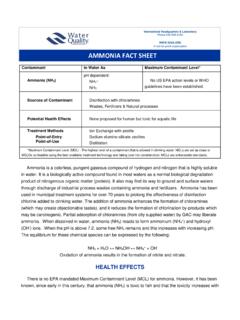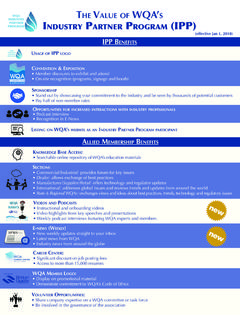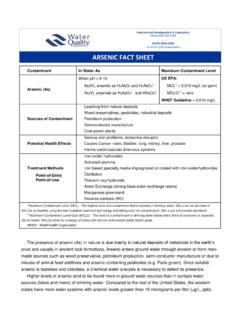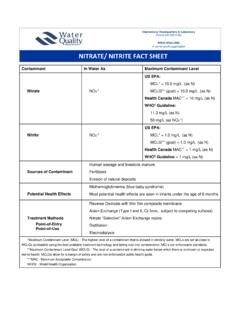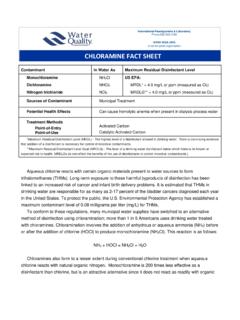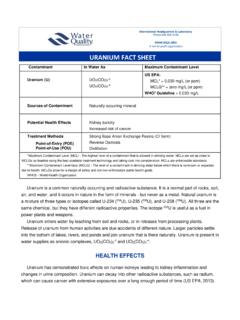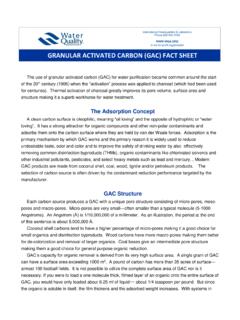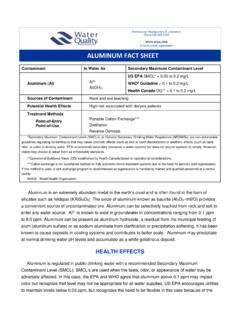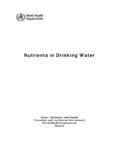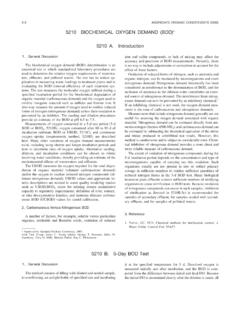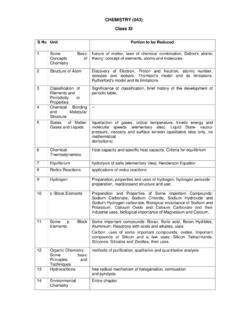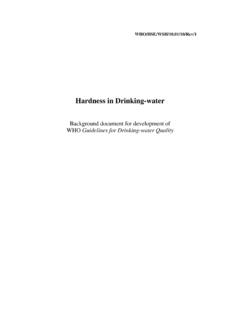Transcription of BARIUM FACT SHEET - Water Quality Association
1 Contaminant In Water As Maximum Contaminant Level BARIUM (Ba) Ba2+ US EPA: MCL* = mg/L (or ppm) MCLG** = mg/L WHO Guideline = mg/L Health Canada MAC** = mg/L Sources of Contaminant Mineral deposits Disposal of drilling wastes Smelting of copper Motor vehicle parts manufacturing Potential Health Effects Difficulties in breathing, increased blood pressure, changes in heart rhythm, stomach irritation, brain swelling, muscle weakness, and damage to the liver, kidney, heart, and spleen. Treatment Methods Point-of-Entry (POE) Point-of-Use (POU) Cation Exchange Reverse Osmosis Distillation *Maximum Contaminant Level (MCL) The highest level of a contaminant that is allowed in drinking Water .
2 MCLs are set as close to MCLGs as feasible using the best available treatment technology and taking cost into consideration. MCLs are enforceable standards. **Maximum Contaminant Level Goal (MCLG) - The level of a contaminant in drinking Water below which there is no known or expected risk to health. MCLGs allow for a margin of safety and are non-enforceable public health goals. **Maximum Acceptable Concentration (MAC) Health Canada regulated highest level allowed in drinking Water . WHO - World Health Organization BARIUM FACT SHEET International Headquarters & Laboratory Phone 630 505 0160 A not-for-profit organization WQA Technical Fact SHEET : BARIUM BARIUM is a divalent cation and alkaline earth metal that can be found in naturally occurring mineral deposits.
3 The most common ores are found in Alaska, Arkansas, California, Georgia, Kentucky, Montana, Nevada, and Tennessee. In 2010, 670 thousand tons of barite, a natural BARIUM sulfate ore, were mined in the US, most of it in Nevada. By 2010, 95% of barite sold in US was used as a weighting agent in natural gas and oil field drilling (USGS, 2011). Although it is also used in making a wide variety of electronic components, in metal alloys, bleaches, dyes, fireworks, ceramics and glass. BARIUM is released to Water and soil in the discharge and disposal of drilling wastes, from the smelting of copper, and the manufacture of motor vehicle parts and accessories.
4 HEALTH EFFECTS The health effects of the different BARIUM compounds depend on how well the compound dissolves in Water . BARIUM compounds that do not dissolve well in Water are not generally harmful and are often used by doctors for medical purposes. If the sulfate concentration in the Water is high, then the precipitation of BARIUM as a sulfate salt reduces its potential for adverse health effects. Those BARIUM compounds that dissolve well in Water may cause harmful health effects in people. Ingesting high levels of soluble BARIUM compounds over the short term has resulted in difficulties in breathing, increased blood pressure, changes in heart rhythm, stomach irritation, brain swelling, muscle weakness, and damage to the liver, kidney, heart, and spleen.
5 Animal studies have found increased blood pressure and changes in the heart from ingesting BARIUM over a long time. Based on such studies , the United States environmental Protection Agency (US EPA) has set a Maximum Contaminant Level Goal (MCLG) at mg/L (or ppm) in Water . The federal Safe Drinking Water Act Maximum Contaminant Level (MCL) also has been set at the same ( ppm) level by EPA. TREATMENT METHODS Residential Point-of-Entry Point-of-Use Cation Exchange Reverse Osmosis Distillation Municipal Lime Softening Cation Exchange Reverse Osmosis Visit or to search for products certified to NSF/ANSI 44, 58, 62, and WQA S-300 for BARIUM reduction claims.
6 When proper regeneration procedures are employed, BARIUM along with calcium and magnesium are effectively exchanged to sodium by conventional point-of-entry (POE) cation exchange Water softeners. BARIUM break through occurs after hardness due the three times greater affinity of BARIUM ions over either calcium or magnesium ions for cation exchange Water softening resins. WQA Technical Fact SHEET : BARIUM Point-of-use (POU) reverse osmosis and distillation are also effective at reducing BARIUM concentrations in drinking Water . There are many POU and POE units of this type tested and certified for effective BARIUM reduction. Consumers can make use of such information by contacting the Water Quality Association , NSF International, and Underwriters Laboratories.
7 Any treatment method that concentrates BARIUM , as is the case with ion exchange softening, reverse osmosis, and distillation may cause precipitation. BARIUM sulfate will precipitate at concentrations of 2 ppm or greater. If the sulfate level in the raw Water is greater than 2 ppm, BARIUM sulfate precipitation is likely. Over time this precipitation may coat and foul the system. BARIUM sulfate is very insoluble and difficult to clean and may thus require replacement of membrane modules, the resin media, or even distiller heating elements after some time of usage. As part of the installation procedure of a POE system, its performance characteristics should be verified by tests conducted under established test procedures and Water analyses.
8 Thereafter, if high BARIUM is found to be present in the influent Water , the treated Water should be monitored periodically to verify continued performance. The Water treatment equipment must be controlled diligently to ensure that acceptable feedwater conditions and equipment capacity are not exceeded. The treatment methods listed herein are generally recognized as techniques that can effectively reduce the listed contaminants sufficiently to meet or exceed the relevant MCL. However, this list does not reflect the fact that point-of-use/point-of-entry (POU/POE) devices and systems currently on the market may differ widely in their effectiveness in treating specific contaminants, and performance may vary from application to application.
9 Therefore, selection of a particular device or system for health contaminant reduction should be made only after careful investigation of its performance capabilities based on results from competent equipment validation testing for the specific contaminant to be reduced. Visit to locate Water professionals in your area. Note that Certified Water Specialists have passed the Water treatment educational program with the Water Quality Association and continue their education with recertification every 3 years. REGULATIONS In the United States the EPA, under the authority of the Safe Drinking Water Act (SDWA), has set the Maximum Contaminant Level Goal (MCLG) for BARIUM at mg/L or ppm.
10 This is the health-based goal at which no known or anticipated adverse effects on human health occur and for which an adequate margin of safety exists. The US EPA has set Maximum Contaminant Level (MCL) for BARIUM in drinking Water at their MCLG s. The utility must take certain steps to correct the problem if the Water exceeds the limit and they must notify citizens of all violations of the standard. World Health Organization has set their guideline value for BARIUM at mg/Liter (WHO, 2004). REFERENCES/SOURCES Health Canda (January 1990). Water Quality : BARIUM . Retreived from semt/pubs/ Water -eau/ BARIUM - US EPA (September 17, 2013).
